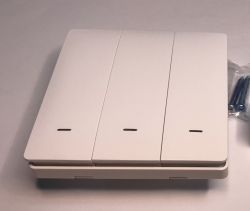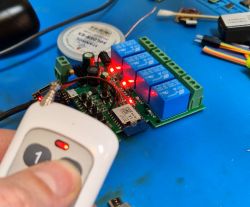FAQ
TL;DR: Two clear paths (DIY vs. installer) and "Monitoring need not be excluded." Unify blinds, heating, ventilation, DHW, lights, gates, and outlets in one app, and keep CCTV in a second app. Decide budget and skills, then pick a local‑first platform. [Elektroda, Anonymous, post #19496601]
Why it matters: Picking the right architecture early avoids lock‑in and keeps future expansions smooth for phone-based home control.
Quick Facts
- Local-first control exists: HomeMatic with CCU3 works without the cloud and has modules for shutters, windows, and heating. [Elektroda, Anonymous, post #19496667]
- Supla runs in the vendor cloud or on your own Raspberry Pi; DIY extensions are supported. [Elektroda, steve2, post #19496607]
- Satel’s mobile app shows camera previews and can trigger macros like opening a gate. [Elektroda, skyguy, post #19499197]
- A DHW boiler can be switched by a smart relay and scheduled from the app. [Elektroda, steve2, post #19496831]
- Control panels and multi-speed functions can be driven by a 4‑relay module with timed schedules. [Elektroda, steve2, post #19496831]
What’s the best way to control blinds, heating, ventilation, DHW, lights, cameras, and gates from one phone app?
Most robust platforms don’t embed CCTV. Use one app for automation and a second for cameras. The rest of your list fits a single platform well. An installer notes, “I have not heard a serious Smart Home system that supports CCTV.” Scenes and schedules keep control consistent. This split keeps both sides stable and easy to manage. [Elektroda, Interesant, post #19496460]
Which platform offers local, cloud‑free control with dedicated modules?
HomeMatic with a CCU3 controller runs locally without the cloud. It includes modules for roller shutters, windows, and traditional heating. You can extend it with custom electronics. Edge case: Electric underfloor heating may lack ready‑made modules, so plan custom work. This keeps control private and responsive. [Elektroda, Anonymous, post #19496667]
Is there a low‑cost, DIY‑friendly platform in Poland?
Yes—Supla by Zamel fits DIY builds. Use the vendor cloud or run a local server on Raspberry Pi. If a device is missing, build it and integrate it. Start small and expand room by room. This keeps costs manageable while you learn. [Elektroda, steve2, post #19496607]
Can I get thermostat‑like control for electric floor heating in Supla today?
The current Supla release lacks a native thermostat. Handle control using an ESP8266 with scripts for now. Alternatively, pair a standalone thermostat with a Supla relay for app control. Check the Supla forum for examples and updates. You can migrate to native support when released. [Elektroda, steve2, post #19496753]
How do I schedule multi‑speed mechanical ventilation from my phone?
Drive each fan speed with a relay output and build time schedules. Many control panels can be wrapped by a 4‑relay module to select modes. Create quiet, normal, and boost time blocks. Map one relay per speed and avoid simultaneous activations. This yields simple, dependable ventilation control. [Elektroda, steve2, post #19496831]
How do I switch a hot‑water boiler (DHW) on a schedule from my phone?
Use a smart relay to switch the boiler’s control circuit. Create day and night schedules, plus a manual override. How‑To:
- Install a relay rated for the boiler enable input or contactor.
- Wire the relay in series with the boiler enable.
- Add on/off schedules and an override scene.
This provides predictable comfort and savings. [Elektroda, steve2, post #19496831]
Do electric heating cables modulate current or just switch on/off?
Electric underfloor heating thermostats typically switch the load on/off. They use floor or air sensors to decide when to heat. Advanced models use PWM or SSRs to vary duty cycle, not voltage amplitude. This protects cables and holds temperature tightly. “PWM controls time, not power level.” [Warmup, 2023]
What skills and budget should I expect for a whole‑home phone‑controlled setup?
Choose between DIY and hiring an integrator. DIY needs electrical and some programming skill. Outsourcing costs more but saves time and risk. “You can make a low‑budget system… or outsource it,” one pro notes. Define scope, timeline, and support upfront to avoid surprises. [Elektroda, Anonymous, post #19496601]
Can I open the entrance gate and wicket from the same app and tie actions to camera views?
Yes, with systems like Satel. The mobile app supports camera previews and macros to trigger actions. Assign a macro to a view to open a gate. You can also control the alarm in the same app. One remote can operate gates, lights, and more. [Elektroda, skyguy, post #19499197]
How should I define “control” for heating, ventilation, and DHW when planning?
Decide if you need simple on/off or full temperature and speed control. This changes device and wiring choices. For ventilation, specify gears and time slots. For heating, confirm sensor types and safety limits. Clear definitions prevent redesigns and extra costs. [Elektroda, Anonymous, post #19496667]
Do I need to exclude cameras to keep my build simple?
No. Keep cameras in a separate app if your main platform lacks CCTV. You can automate the rest under one app. This split improves stability and support. It avoids brittle, unsupported integrations. “Monitoring need not be excluded.” [Elektroda, Anonymous, post #19496601]
Should I use Supla’s cloud or self‑host it?
Use the vendor cloud for quick setup and remote access. Self‑host on a Raspberry Pi for privacy and offline resilience. Both options live within the same ecosystem. Choose based on comfort and uptime needs. You can switch later if requirements change. [Elektroda, steve2, post #19496607]
Can a private user get Ampio’s configurator without certification?
Policies change, and many pro systems restrict configurators to certified partners. Contact Ampio to confirm current access, training, or paid options. Ask about end‑user profiles for minor adjustments. Clarify support and warranty implications beforehand. This keeps control without breaching vendor terms. [Ampio, 2024]






